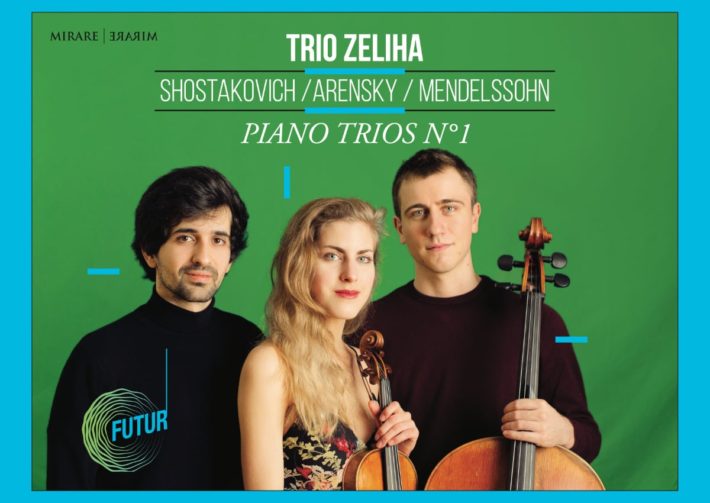Founded in 2018, Trio Zeliha – Jorge González Buajasan (piano), Manon Galy (violin) and Maxime Quennesson (cello) – is relatively new on the scene but already has some distinguished mentors, among them Alfred Brendel and the Modigliani Quartet.
‘Suspenseful’ is the word that comes to mind in the performance of the C minor trio (track 1), which Shostakovich wrote when he was just 16. Even in this early a composition, there are hints of elements that would eventually become his defining characteristics, such as stark juxtapositions and a penchant for the macabre.
The lyrical opening hints at a lurking, sinister presence; though we anticipate its eventual arrival, we’re still not quite prepared for the furious outburst at 1:26. The excitement of the entire work in fact stems from its highly mercurial nature, and this is exactly what the group captures so well. They also use the spurts of rhythmic drive throughout to impart both an impish charm and a more devilish edge where it’s needed. Another thing that struck me in this interpretation was its cohesiveness – it is rare to hear an ensemble this synchronized. The technical and musical partnership is flawless: handoffs of themes and accompaniment are well executed, as is a consistency of articulation and phrasing across each instrument.
Even more importantly, there is an inherent musical understanding between the performers as seen in moments like the breathtaking section that begins at 4:24. The piano accompaniment, sounding like delicate chimes, plays an integral role in both supporting and enhancing a beautiful melody from the cello that drifts seamlessly to the violin. The enthralling conclusion, too, shows an intelligently thought out balance – the piano really holds its own against the two string parts, and this results in a synergistic effect, a sense that we’re listening to more than just three performers.
Related Classical Music Reviews
- Review: Mendelssohn Piano Trios No. 1 & 2 – Trio Metral
- Review: Saint-Saëns – Chamber Works – Chamayou, Capuçon, Moreau
- Review: Ravel – Piano Trio, Chausson – Piano Quartet – Trio Machiavelli
Anton Arensky’s 1895 Trio in D minor takes us back to the effusive Romanticism of composers like Tchaikovsky. The polished take of the Allegro moderato (track 2) goes one step beyond the unity of the Shostakovich, now also letting each instrument’s character come through. The opening theme alone takes on a range of nuanced transformations as it switches between instruments, going from contemplative in the violin to mellifluous in the cello. The piano brings out the middle section’s playfulness with a pleasing clarity, and when all the instruments come together in the most climactic points, a sweeping orchestral quality emerges.
The Elegia (track 4), despite being a quieter movement, is probably the most gripping. Trio Zeliha’s top-notch musicianship is unmistakable here. The tone quality of the strings lends a feeling of empathy to the movement’s aching sorrow, which the piano amplifies with a layer of well-harmonized chorale textures. The middle section has a graceful brightness – the delicate pizzicatos, good bow-control, and a hopeful piano melody balances out the emotionally denser outer sections.
Mendelssohn’s D minor piano trio rounds out the recording and continues to embody the album’s central theme: a ‘hyper-Romanticism’ that the artists say lets the listener get carried away in a swirling, tortured universe. As in the other works, they maximize emotive boundaries but without sacrificing the idiom: even the most impassioned sections respect the composer’s light and refined style. The pianist in the first movement creates many of its dramatic swirls (all the while maintaining a pristine tone) which brings even more dynamism to the string parts. The Scherzo (track 8), one of the more joyful movements on the album, is all about technical precision. That’s not to say, however, that it is devoid of character: Trio Zeliha brings out much of the delightful capriccioso that we associate with Mendelssohn.
The sound engineering gives each instrument an equal amount of presence, something that is of central importance to works with as many moving parts as these presented here. This well-defined balance is actually what helps give the group a larger-than-life power in the most dramatic moments. For those who don’t read French, the liner notes may seem all but an accessory, but that does little to take away from a performance that already speaks for itself. This is a successful debut indeed, and it puts Trio Zeliha on the map as an ensemble with a bright musical future.

Shostakovich – Piano Trio No. 1, Op. 8
Arensky – Piano Trio Op. Op. 32
Mendelssohn – Piano Trio Op. 49
Trio Zeliha:
Jorge González Buajasan – Piano
Manon Galy – Violin
Maxime Quennesson – Cello
Mirare, CD MIR522
Recommended Comparisons
Read more classical music reviews or visit The Classic Review Amazon store
Follow Us and Comment:
Get our periodic classical music newsletter with our recent reviews, news and beginners guides.
We respect your privacy.








